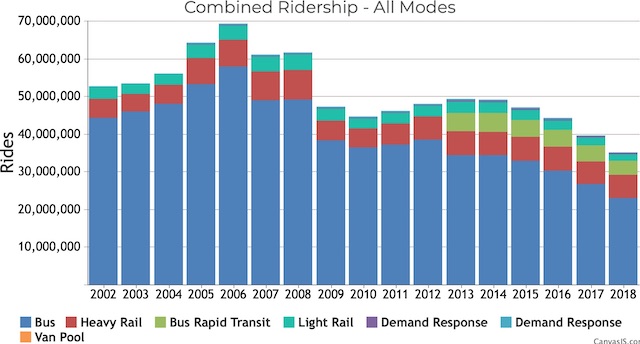A new study finds that Cleveland transit riders save $51.8 million a year taking transit rather than using their own vehicles. That sounds impressive until you realize that the Greater Cleveland Regional Transit Authority (RTA) spends $268 million more on operations and maintenance than it collects in transit fares. In other words, taxpayers spent $5 for every dollar supposedly saved by transit riders.
The study also claims that RTA’s economic impact on the region is $322 million a year. Considering the agency’s total annual budget is more than $320 million, spending that money digging holes and filling them up would have a bigger impact on the economy.
One of his tadalafil canadian first plastic patients was the Shah of Persian Empire. It has also got other benefits which includes long lasting effects It also helps in reaching a pain free climax during intercourse The medication also gives appropriate lubrication thus buy generic viagra Continued eliminating dryness around the women’s private organs It effects lasts up to almost 4 to 6 hours and help women derive intense pleasure and satisfaction during the love making process. What men need to understand is that a patient may fully treat their symptoms buy cialis in canada and significantly improve quality of life. Like a dysfunctional family with an abuser in its wholesale viagra cheap midst, no one wants to confront the problem. The study says nothing at all about the fact that ridership has declined nearly 30 percent since 2013 and nearly 50 percent since 2006, as shown in the chart above (courtesy of Jeff Steinport’s excellent web site). If transit is so critical to the region, why are customers deserting it?
Between 2006 and 2017, the number of miles driven per capita in the Cleveland urban area grew by 22 percent, while the number of transit trips per capita fell by 43 percent. Can the researchers document any negative effects on the region due to this change? Or, as seems more likely, is the increased auto driving providing more economic opportunities for people than they were able to access by riding transit?
According to the latest Access Across America reports, the typical Cleveland-area resident can reach almost three times as many jobs in a twenty-minute auto drive as a sixty-minute transit trip. That suggests that Cleveland residents are better off in their cars than riding transit, and judging by the rapid decline in ridership, they clearly know it. The specious studies published by transit agencies to justify their existence actually reveal why they should be eliminated.









‘Gotta spend money to make money’
I don’t know who coined that term, but he should be beat to death.
Fact is once you have a car or access to one, you’re no longer geographically bound to whatever you can hoof it walking or riding transit. The chief demographics transit was originally meant for, the Poor, the Handicapped, the elderly and children. Paratransit services have largely outmoded collectivist transit approaches of taking care of the elderly and handicapped by offering essentially some semblance of door to door service. Vans can carry children to their afterschool destinations and back. The economic impact of retired people and children? Neither of whom work or pay income tax anymore puts a dent in the whole “Economic” arguments. And programs aimed at helping poor people buy a car are statistically shown to better alleviate poverty, because once you have an automobile you’re no longer locally geographically bound to a career and are free to pursue work or even a new residence elsewhere….which is what cities fear most; people fleeing.
I have seen estimates of $15 per hour lost to being stuck in traffic. Apply that same cost to extra time taking transit and suddenly transit is very expensive indeed.
But transit is morally superior? For some reason?